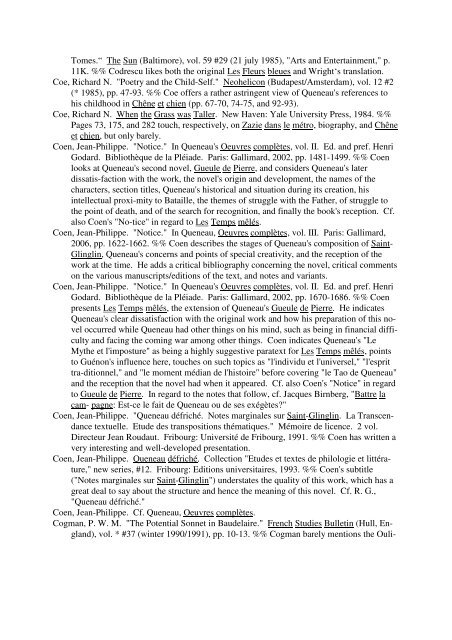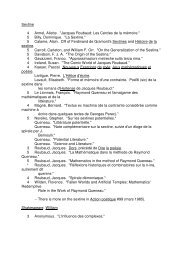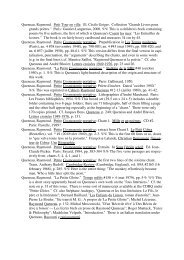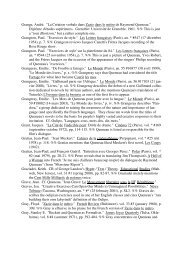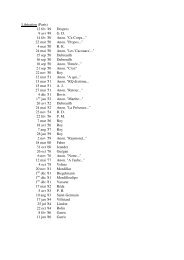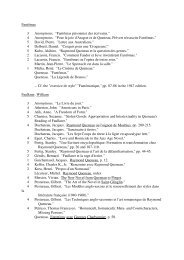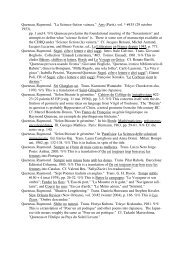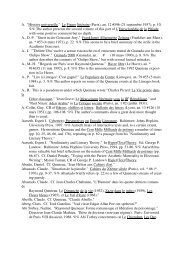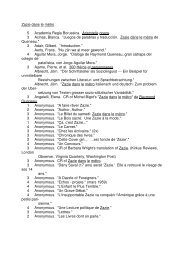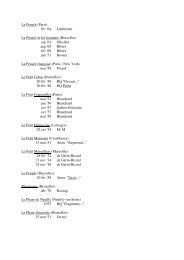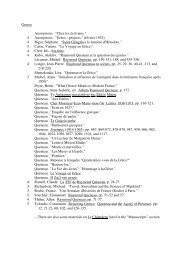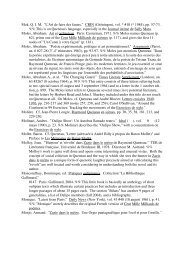Chabanne, Jean-Charles. "En lisant les lecteurs ... - Fonds Queneau
Chabanne, Jean-Charles. "En lisant les lecteurs ... - Fonds Queneau
Chabanne, Jean-Charles. "En lisant les lecteurs ... - Fonds Queneau
You also want an ePaper? Increase the reach of your titles
YUMPU automatically turns print PDFs into web optimized ePapers that Google loves.
Tomes.“ The Sun (Baltimore), vol. 59 #29 (21 july 1985), "Arts and <strong>En</strong>tertainment," p.<br />
11K. %% Codrescu likes both the original Les Fleurs bleues and Wright‘s translation.<br />
Coe, Richard N. "Poetry and the Child-Self." Neohelicon (Budapest/Amsterdam), vol. 12 #2<br />
(* 1985), pp. 47-93. %% Coe offers a rather astringent view of <strong>Queneau</strong>'s references to<br />
his childhood in Chêne et chien (pp. 67-70, 74-75, and 92-93).<br />
Coe, Richard N. When the Grass was Taller. New Haven: Yale University Press, 1984. %%<br />
Pages 73, 175, and 282 touch, respectively, on Zazie dans le métro, biography, and Chêne<br />
et chien, but only barely.<br />
Coen, <strong>Jean</strong>-Philippe. "Notice." In <strong>Queneau</strong>'s Oeuvres complètes, vol. II. Ed. and pref. Henri<br />
Godard. Bibliothèque de la Pléiade. Paris: Gallimard, 2002, pp. 1481-1499. %% Coen<br />
looks at <strong>Queneau</strong>'s second novel, Gueule de Pierre, and considers <strong>Queneau</strong>'s later<br />
dissatis-faction with the work, the novel's origin and development, the names of the<br />
characters, section tit<strong>les</strong>, <strong>Queneau</strong>'s historical and situation during its creation, his<br />
intellectual proxi-mity to Bataille, the themes of struggle with the Father, of struggle to<br />
the point of death, and of the search for recognition, and finally the book's reception. Cf.<br />
also Coen's "No-tice" in regard to Les Temps mêlés.<br />
Coen, <strong>Jean</strong>-Philippe. "Notice." In <strong>Queneau</strong>, Oeuvres complètes, vol. III. Paris: Gallimard,<br />
2006, pp. 1622-1662. %% Coen describes the stages of <strong>Queneau</strong>'s composition of Saint-<br />
Glinglin, <strong>Queneau</strong>'s concerns and points of special creativity, and the reception of the<br />
work at the time. He adds a critical bibliography concerning the novel, critical comments<br />
on the various manuscripts/editions of the text, and notes and variants.<br />
Coen, <strong>Jean</strong>-Philippe. "Notice." In <strong>Queneau</strong>'s Oeuvres complètes, vol. II. Ed. and pref. Henri<br />
Godard. Bibliothèque de la Pléiade. Paris: Gallimard, 2002, pp. 1670-1686. %% Coen<br />
presents Les Temps mêlés, the extension of <strong>Queneau</strong>'s Gueule de Pierre. He indicates<br />
<strong>Queneau</strong>'s clear dissatisfaction with the original work and how his preparation of this novel<br />
occurred while <strong>Queneau</strong> had other things on his mind, such as being in financial difficulty<br />
and facing the coming war among other things. Coen indicates <strong>Queneau</strong>'s "Le<br />
Mythe et l'imposture" as being a highly suggestive paratext for Les Temps mêlés, points<br />
to Guénon's influence here, touches on such topics as "l'individu et l'universel," "l'esprit<br />
tra-ditionnel," and "le moment médian de l'histoire" before covering "le Tao de <strong>Queneau</strong>"<br />
and the reception that the novel had when it appeared. Cf. also Coen's "Notice" in regard<br />
to Gueule de Pierre. In regard to the notes that follow, cf. Jacques Birnberg, "Battre la<br />
cam- pagne: Est-ce le fait de <strong>Queneau</strong> ou de ses exégètes?"<br />
Coen, <strong>Jean</strong>-Philippe. "<strong>Queneau</strong> défriché. Notes margina<strong>les</strong> sur Saint-Glinglin. La Transcendance<br />
textuelle. Etude des transpositions thématiques." Mémoire de licence. 2 vol.<br />
Directeur <strong>Jean</strong> Roudaut. Fribourg: Université de Fribourg, 1991. %% Coen has written a<br />
very interesting and well-developed presentation.<br />
Coen, <strong>Jean</strong>-Philippe. <strong>Queneau</strong> défriché. Collection "Etudes et textes de philologie et littérature,"<br />
new series, #12. Fribourg: Editions universitaires, 1993. %% Coen's subtitle<br />
("Notes margina<strong>les</strong> sur Saint-Glinglin") understates the quality of this work, which has a<br />
great deal to say about the structure and hence the meaning of this novel. Cf. R. G.,<br />
"<strong>Queneau</strong> défriché."<br />
Coen, <strong>Jean</strong>-Philippe. Cf. <strong>Queneau</strong>, Oeuvres complètes.<br />
Cogman, P. W. M. "The Potential Sonnet in Baudelaire." French Studies Bulletin (Hull, <strong>En</strong>gland),<br />
vol. * #37 (winter 1990/1991), pp. 10-13. %% Cogman barely mentions the Ouli-


